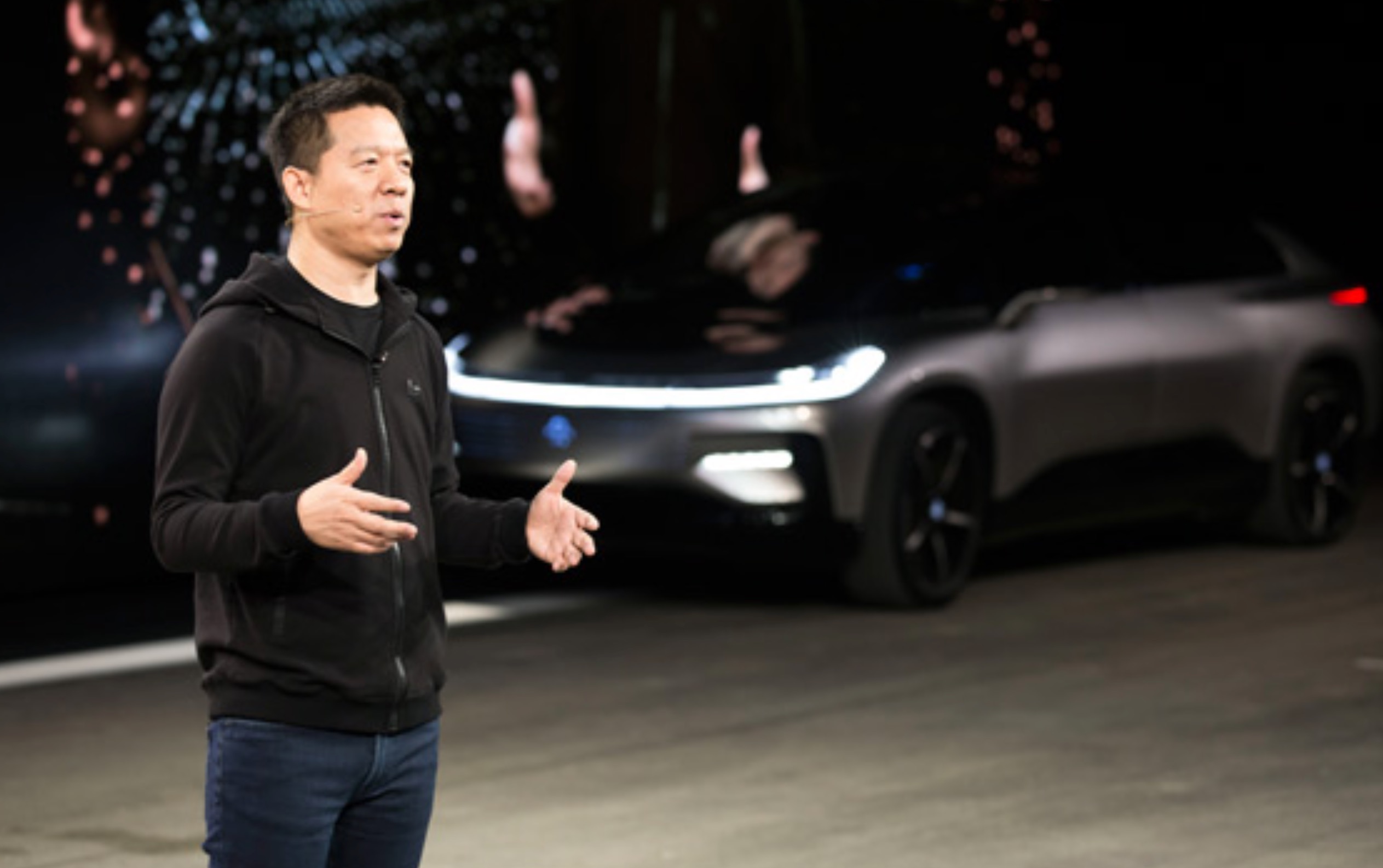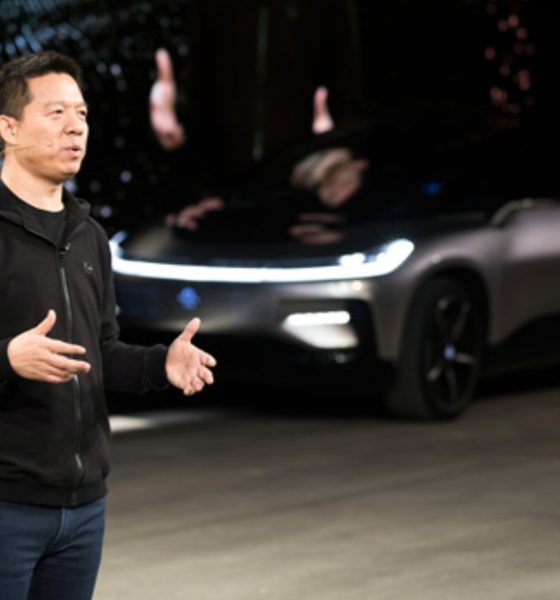

News
Once-promising Tesla rival Faraday Future hits roadblock amid CEO’s $800M controversy
Once-promising and outspoken Tesla rival Faraday Future has hit another roadblock, as CEO Jia Yueting is being accused by an investor of spending $800 million worth of funds and then attempting to back out of the deal. The investor in question, the healthcare division of Chinese real estate group Evergrande, has noted that it will take “all necessary actions” to protect itself and its shareholders.
Faraday Future has been beset by multiple delays and problems over the past years. Once the company that is branding itself as a startup that would dethrone Tesla from its place in the premium electric car market, the electric car startup has met a slew of problems, from dire financial straits to an exodus of key executives. In addition, Faraday Future’s first vehicle, the ultra-luxury FF 91 SUV, has yet to start production.
Faraday Future received a much-needed lifeline at the end of 2017 by securing a $2 billion investment from Evergrande Health–a subsidiary of property developer China Evergrande Group. Evergrande noted that it had agreed to buy Season Smart Ltd, a firm which owns 45% of Faraday Future, for $860.2 million. The Chinese property developer also agreed to pay Faraday Future $1.2 billion in two installments which are due in 2019 and 2020.
This Sunday, Evergrande revealed that it had signed a supplemental agreement to pay the electric car maker $700 million ahead of schedule. And now, Evergrande noted that Faraday Future CEO Jia Yueting had initiated an arbitration at the Hong Kong Arbitration Center against the Chinese firm, claiming that the promised payment was not fulfilled. Reuters noted that the CEO’s arbitration aims to deprive Evergrande rights as a shareholder for electric car startup as well.
Its trouble with Evergrande is just one of the company’s concerns. Speaking with former employees of the electric car startup, The Verge has noted that Faraday Future is allegedly struggling once more despite the company having spent around $800 million. Due to the company’s alleged financial troubles, the former FF employees claimed that vendors and suppliers had not been paid, and layoffs are being considered. In what seems to be a stroke of misfortune, the company’s first pre-production version of the FF91 reportedly caught fire in late September after the vehicle was showcased at a “Futurist Day” event for employees and their families.
Much of Faraday Future’s troubles are connected to the activities of its CEO. Last year, Jia found himself in China’s official “Blacklist” for credit defaulters. Due to his assets being frozen in China, the Faraday Future CEO currently resides in the United States. His handling of the electric car startup has been polarizing at best. Last year, for example, a disagreement between Jia and Faraday Future’s then-CFO turned public, compromising an attempt to restructure the company through bankruptcy.
It remains to be seen if Faraday Future could eventually get the vehicle to market. When the FF 91 was unveiled, the electric car startup compared it favorably against the Tesla Model S P100D. The FF 91 is a large SUV has a 0-60 mph time of 2.4 seconds, a 130 kWh battery pack, and a range of 289 miles per charge. The vehicle also features a number of nifty tricks, such as LiDAR for self-driving capabilities and four-wheel steering, which gives the vehicle impressive maneuverability.

Elon Musk
Elon Musk’s X will start using a Tesla-like software update strategy
The initiative seems designed to accelerate updates to the social media platform, while maintaining maximum transparency.

Elon Musk’s social media platform X will adopt a Tesla-esque approach to software updates for its algorithm.
The initiative seems designed to accelerate updates to the social media platform, while maintaining maximum transparency.
X’s updates to its updates
As per Musk in a post on X, the social media company will be making a new algorithm to determine what organic and advertising posts are recommended to users. These updates would then be repeated every four weeks.
“We will make the new 𝕏 algorithm, including all code used to determine what organic and advertising posts are recommended to users, open source in 7 days. This will be repeated every 4 weeks, with comprehensive developer notes, to help you understand what changed,” Musk wrote in his post.
The initiative somewhat mirrors Tesla’s over-the-air update model, where vehicle software is regularly refined and pushed to users with detailed release notes. This should allow users to better understand the details of X’s every update and foster a healthy feedback loop for the social media platform.
xAI and X
X, formerly Twitter, has been acquired by Elon Musk’s artificial intelligence startup, xAI last year. Since then, xAI has seen a rapid rise in valuation. Following the company’s the company’s upsized $20 billion Series E funding round, estimates now suggest that xAI is worth tens about $230 to $235 billion. That’s several times larger than Tesla when Elon Musk received his controversial 2018 CEO Performance Award.
As per xAI, the Series E funding round attracted a diverse group of investors, including Valor Equity Partners, Stepstone Group, Fidelity Management & Research Company, Qatar Investment Authority, MGX, and Baron Capital Group, among others. Strategic partners NVIDIA and Cisco Investments also continued support for building the world’s largest GPU clusters.
News
Tesla FSD Supervised wins MotorTrend’s Best Driver Assistance Award
The decision marks a notable reversal for the publication from prior years, with judges citing major real-world improvements that pushed Tesla’s latest FSD software ahead of every competing ADAS system.

Tesla’s Full Self-Driving (Supervised) system has been named the best driver-assistance technology on the market, earning top honors at the 2026 MotorTrend Best Tech Awards.
The decision marks a notable reversal for the publication from prior years, with judges citing major real-world improvements that pushed Tesla’s latest FSD software ahead of every competing ADAS system. And it wasn’t even close.
MotorTrend reverses course
MotorTrend awarded Tesla FSD (Supervised) its 2026 Best Tech Driver Assistance title after extensive testing of the latest v14 software. The publication acknowledged that it had previously criticized earlier versions of FSD for erratic behavior and near-miss incidents, ultimately favoring rivals such as GM’s Super Cruise in earlier evaluations.
According to MotorTrend, the newest iteration of FSD resolved many of those shortcomings. Testers said v14 showed far smoother behavior in complex urban scenarios, including unprotected left turns, traffic circles, emergency vehicles, and dense city streets. While the system still requires constant driver supervision, judges concluded that no other advanced driver-assistance system currently matches its breadth of capability.
Unlike rival systems that rely on combinations of cameras, radar, lidar, and mapped highways, Tesla’s FSD operates using a camera-only approach and is capable of driving on city streets, rural roads, and freeways. MotorTrend stated that pure utility, the ability to handle nearly all road types, ultimately separated FSD from competitors like Ford BlueCruise, GM Super Cruise, and BMW’s Highway Assistant.
High cost and high capability
MotorTrend also addressed FSD’s pricing, which remains significantly higher than rival systems. Tesla currently charges $8,000 for a one-time purchase or $99 per month for a subscription, compared with far lower upfront and subscription costs from other automakers. The publication noted that the premium is justified given FSD’s unmatched scope and continuous software evolution.
Safety remained a central focus of the evaluation. While testers reported collision-free operation over thousands of miles, they noted ongoing concerns around FSD’s configurable driving modes, including options that allow aggressive driving and speeds beyond posted limits. MotorTrend emphasized that, like all Level 2 systems, FSD still depends on a fully attentive human driver at all times.
Despite those caveats, the publication concluded that Tesla’s rapid software progress fundamentally reshaped the competitive landscape. For drivers seeking the most capable hands-on driver-assistance system available today, MotorTrend concluded Tesla FSD (Supervised) now stands alone at the top.
News
Elon Musk’s Grokipedia surges to 5.6M articles, almost 79% of English Wikipedia
The explosive growth marks a major milestone for the AI-powered online encyclopedia, which was launched by Elon Musk’s xAI just months ago.

Elon Musk’s Grokipedia has grown to an impressive 5,615,201 articles as of today, closing in on 79% of the English Wikipedia’s current total of 7,119,376 articles.
The explosive growth marks a major milestone for the AI-powered online encyclopedia, which was launched by Elon Musk’s xAI just months ago. Needless to say, it would only be a matter of time before Grokipedia exceeds English Wikipedia in sheer volume.
Grokipedia’s rapid growth
xAI’s vision for Grokipedia emphasizes neutrality, while Grok’s reasoning capabilities allow for fast drafting and fact-checking. When Elon Musk announced the initiative in late September 2025, he noted that Grokipedia would be an improvement to Wikipedia because it would be designed to avoid bias.
At the time, Musk noted that Grokipedia “is a necessary step towards the xAI goal of understanding the Universe.”
Grokipedia was launched in late October, and while xAI was careful to list it only as Version 0.1 at the time, the online encyclopedia immediately earned praise. Wikipedia co-founder Larry Sanger highlighted the project’s innovative approach, noting how it leverages AI to fill knowledge gaps and enable rapid updates. Netizens also observed how Grokipedia tends to present articles in a more objective manner compared to Wikipedia, which is edited by humans.
Elon Musk’s ambitious plans
With 5,615,201 total articles, Grokipedia has now grown to almost 79% of English Wikipedia’s article base. This is incredibly quick, though Grokipedia remains text-only for now. xAI, for its part, has now updated the online encyclopedia’s iteration to v0.2.
Elon Musk has shared bold ideas for Grokipedia, including sending a record of the entire knowledge base to space as part of xAI’s mission to preserve and expand human understanding. At some point, Musk stated that Grokipedia will be renamed to Encyclopedia Galactica, and it will be sent to the cosmos.
“When Grokipedia is good enough (long way to go), we will change the name to Encyclopedia Galactica. It will be an open source distillation of all knowledge, including audio, images and video. Join xAI to help build the sci-fi version of the Library of Alexandria!” Musk wrote, adding in a later post that “Copies will be etched in stone and sent to the Moon, Mars and beyond. This time, it will not be lost.”








